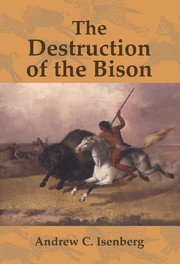Conclusion
Published online by Cambridge University Press: 05 August 2012
Summary
The Indian hunters who came to the western plains in the eighteenth century encountered not only the villagers who already inhabited the region but other interlopers like themselves. The complex and multifaceted encounters that ensued among nomads and villagers became still more complex when Euroamericans arrived in the grasslands. The encounters among Indians and Euroamericans were both intercultural and environmental. Immigrants to the western plains introduced new animals, systems of resource use, and microbes to the region. The newcomers confronted not only other peoples but the semiarid environment. As a result of these cultural and environmental encounters, villagers became nomads, farmers became bison hunters, and bison hunters became destroyers of a species.
The environmental history of the destruction of the bison thus unites two meta-narratives of eighteenth- and nineteenth-century history. First, imperial expansion brought Europeans, their economic system, and their biota into worldwide contact with non-Europeans. The conquest of indigenous peoples in North America was duplicated in South America, southern Africa, Australia, New Zealand, and elsewhere. Second, the migration of European people, plants, animals, and economies overseas occasioned a global decline in biological diversity. Ultimately, European domesticated animals supplanted indigenous wildlife in many parts of the world. Domesticated livestock's displacement of bison in the Great Plains was but one example of this pattern of ecological simplification.
The encounter between European and Indian societies was both a cultural and an ecological phenomenon, converging in the domestication of the plains environment: the transformation of the bison and the grasslands for human convenience.
- Type
- Chapter
- Information
- The Destruction of the BisonAn Environmental History, 1750–1920, pp. 193 - 198Publisher: Cambridge University PressPrint publication year: 2000



